Medu Vada is a popular South Indian breakfast snack of donut shaped lentil fritters that are fluffy, crispy, soft and delicious. If sweet breakfast isn’t your thing, try this recipe for savory spiced donuts made with black gram lentils, spices and herbs. Traditionally paired with Sambar and Coconut Chutney, these make for a comforting, filling and satisfying breakfast or snack.
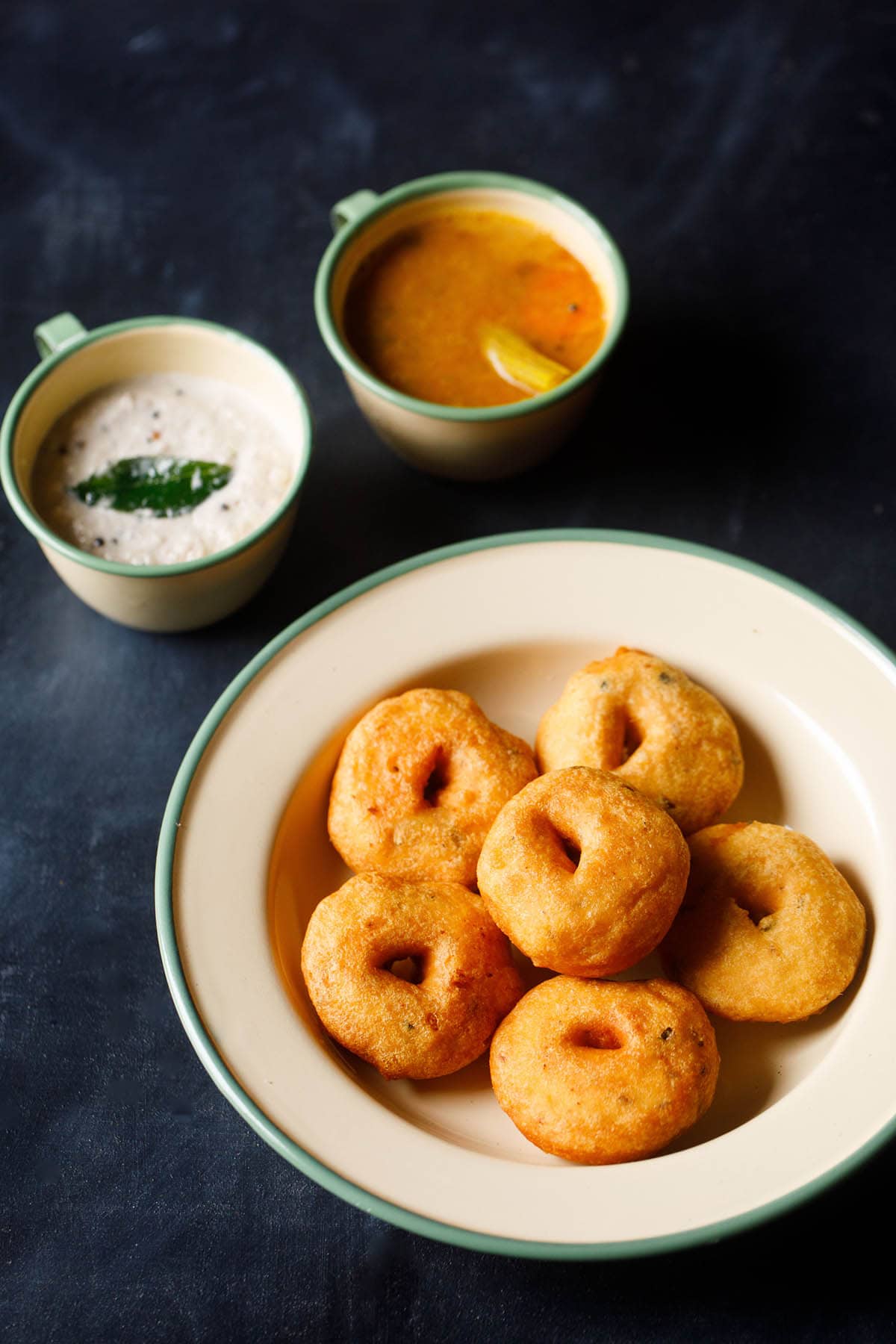
About Vada
If you’re in India and you come across ‘vada’ or ‘bada,’ you must know that this is a category of savory snacks, which are usually fried. Largely, some different variations of these vadas can be classified as cutlets, fritters, dumplings or donuts.
A typical vada can be made using lentils or legumes, vegetables, sago or a combination of all, along with veggies, seasonings, spices and herbs that are added to enhance the taste, texture and nutritive value. Some vada versions include Dahi Vada, Sabudana Vada, Maddur Vada and more.
Vadas found in different regions of India have their own name. For instance, vade, wada, bara, wadeh or vadai. According to the famous Indian food scientist and historian and nutritionist K. T. Achaya, vadai was very common during 100 BCE-300 CE amongst Tamils.
All these various vada have different recipes and methods of preparation. Mostly in many variations, the lentils are soaked and then ground to make a batter. In some variations like in Batata Vada recipe the batter is made from dry gram flour rather than whole lentils with a spiced savory potato stuffing encased inside.
While the term vada is often used interchangeably with medu vada, it should be noted that medu vada is part of the vada family, but not all vada are medu vada. Example this Dal Vada recipe is made with a spiced, savory chana dal batter.
About Medu Vada Recipe
Medu vada is one of my favorite snacks of all time. I loved them as a kid, and they clearly withstand the test of time because they are still one of my most beloved dishes. I love most South Indian snacks because they remind me of my growing up days.
Want more delicious South Indian breakfast tiffin recipes? Try my Rava Dosa, Idli or Masala Dosa!
Medu vada are essentially savory donuts made with black gram, herbs, coconut and spices. The word medu means soft and vada means fritters in Kannada language. This particular type of fritter is also known as:
- Urad Dal Vada in Hindi
- Garelu in Telugu
- Uzhunnu Vada in Malayalam
- Uddina Vada in Kannada
- Medhu Vadai, Ulundu Vadai in Tamil
The hero ingredient in medu vada recipe is urad dal (skinned black gram), but the herbs and spices also add a savory and spicy quality to these fritters that is absolutely addictive. The hotel-style medu vada also includes onions, which lend a lovely sweetness.
If you are making these for kids, you can consider adding extra veggies like grated carrots, shredded cabbage, or grated beetroot to sneak in a little extra nutrition. Hidden vegetables are still vegetables!
I especially like serving the crispy, fluffy medu vada or garelu the traditional way: dunked in hot sambar with coconut chutney by the side.
This popular, satisfying meal that is also called sambar vada with coconut chutney is very famous all over India. It tastes awesome, so is loved by many.
Whenever I make medu vada, I go the extra length to make sambar. While you’re free to serve them with only coconut chutney, vada sambar is one of those joyful foods that bring up many wonderful memories. Don’t you agree?
You can enjoy piping hot vada with any variety of Sambar.
But if you are pressed for time, simply serve with coconut chutney, mint coriander chutney or tomato ketchup.
You could also use any savory or spicy dip of your choice. Remember that medu vada or garelu are fritters, so they’re going to taste delicious no matter what!
Mastering this classic Medhu Vadai recipe does take time and some experience. Making the doughnut shape from the batter is the most difficult step.
Not to worry: I also struggled with it in my earlier days of cooking! Below I share all my tips and tricks that I have learned over the years. I hope you enjoy making them as much as I do.
Are you ready to make the absolute best vada recipe with a light, porous texture inside and crispy on the outside? Just take a look at the photo below. Isn’t the texture incredibly fluffy and soft like a cloud? Yum!
Come along with me in the kitchen and I’ll show you how to make this classic South Indian snack with easy to follow step-by-step photos.
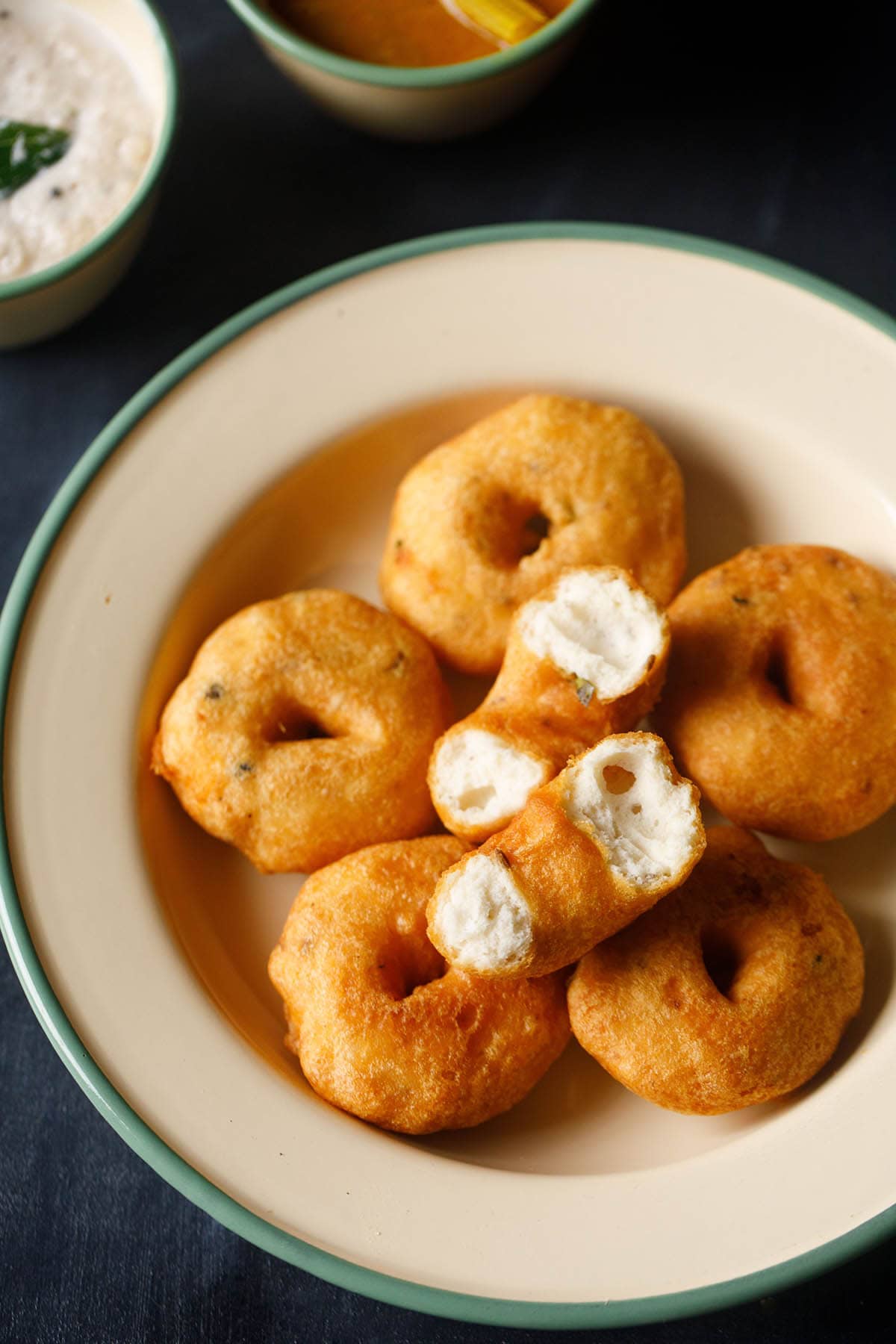
How to make Medu Vada
Soak Lentils
1. Rinse 1 cup urad dal (husked and split or whole black gram) a few times in water. Then soak the lentils in 2.5 to 3 cups water for at least 4 to 5 hours or up to overnight.
Preferably use unpolished urad dal to make this vada recipe.
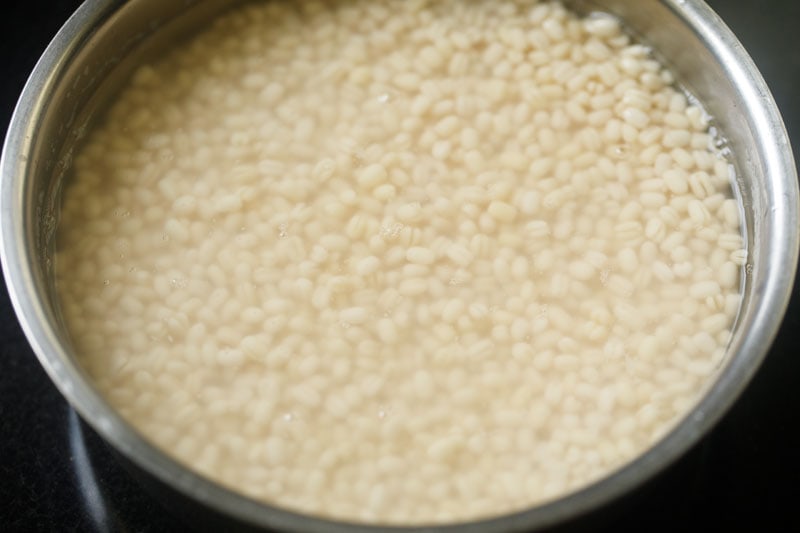
2. Drain and discard the water. Add the soaked urad dal to a grinder jar. Add 3 to 4 tablespoons fresh water or as needed. Just be sure not to make the batter too thin!
Do not add too much water while grinding. The batter should be like a soft moist dough but yet light and fluffy.
It should end up looking like a cake batter rather than a crepe batter. I recommend blending in steps and adding water as needed to achieve the right consistency.
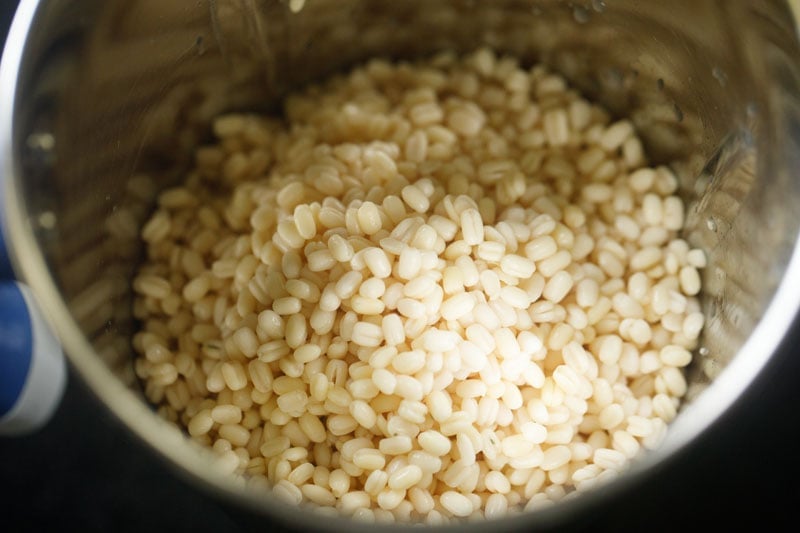
Make Urad Dal Batter
3. Begin to grind or blend the urad dal to a smooth batter. The batter should be fluffy and thick.
You can grind in two batches or one lot depending on the capacity and size of your blender or mixer-grinder.
Scrape down the sides of the blender as you go to ensure all the lentils gets blended to a uniform consistency.
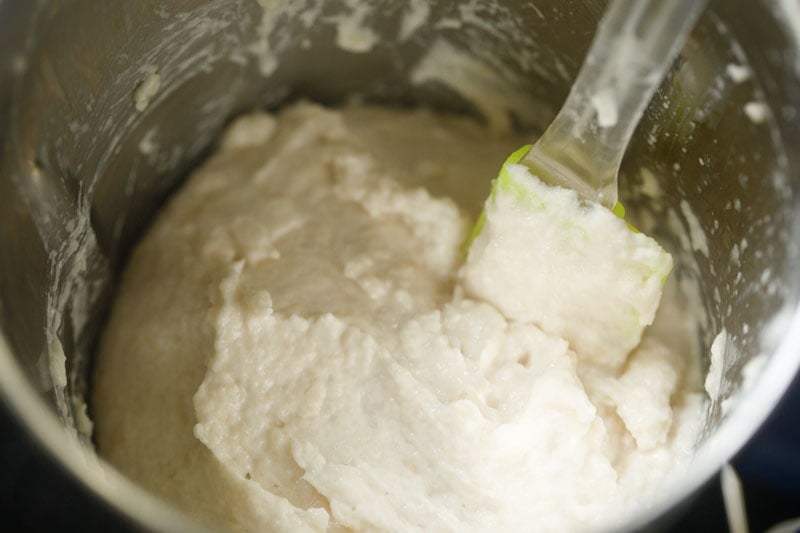
4. Continue to grind at intervals by scraping the sides with a spatula. If your mixer or grinder becomes hot, then wait for a few minutes until it cools down.
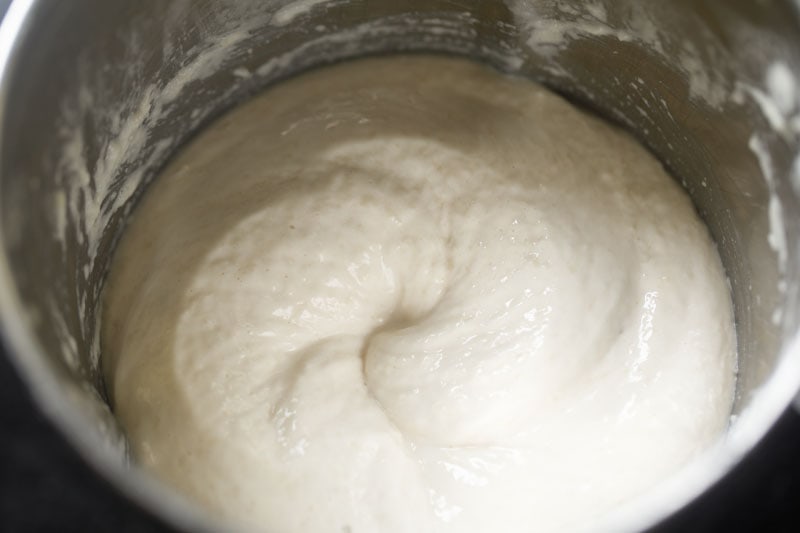
5. Continue to grind or blend until you achieve a smooth, fluffy batter. Remember there should be no fine grits or chunks of urad dal in the batter.
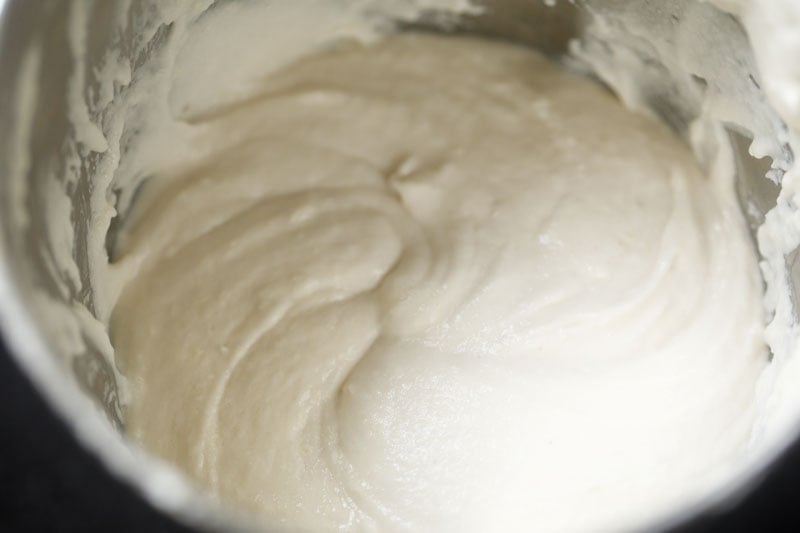
6. Remove the batter into a big bowl or vessel. Then briskly whip with a spatula, spoon or a wired whisk for 2 to 3 minutes. This aerates the batter and gives it a light, fluffy texture.
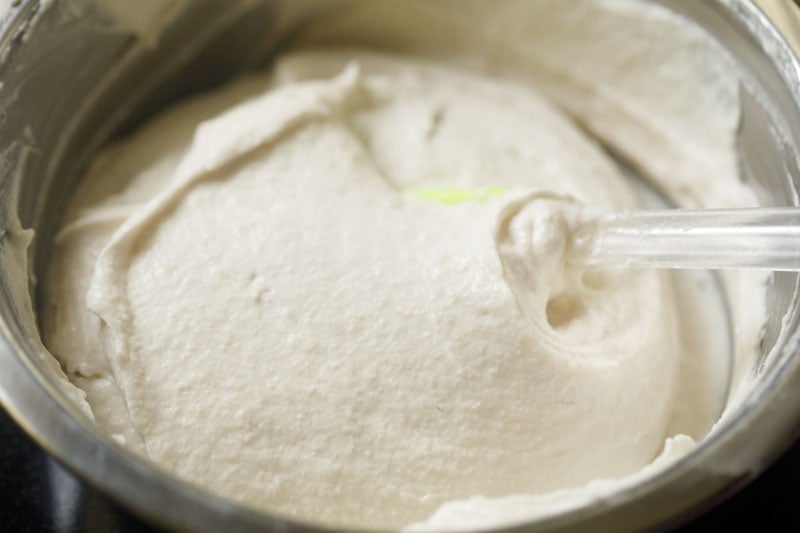
7. In the below photo you see the vada batter that has been aerated by continuously whisking it for few minutes.
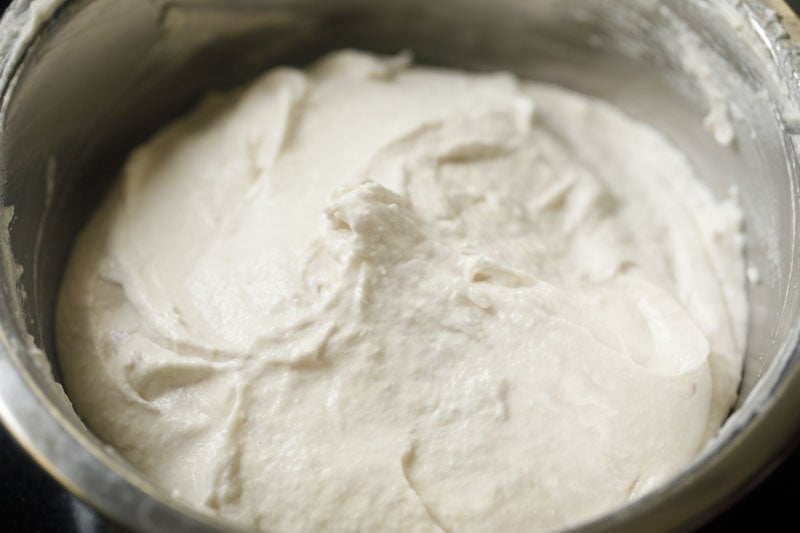
Check Batter Consistency
8. A quick way to check the perfect and right consistency of the batter is to add a small spoon of it in a bowl of water. The batter should float and remain intact. If it floats and does not get dissolved, then you have achieved the right consistency.
If it sinks, this means that your batter is not fluffy enough (with not enough air bubbles trapped in it) or is too thin.
If the batter is too thin, then add some semolina (fine rava or suji) or urad dal flour or rice flour to it to help thicken it up. Rava or suji also helps in giving a crispy texture to the vada.
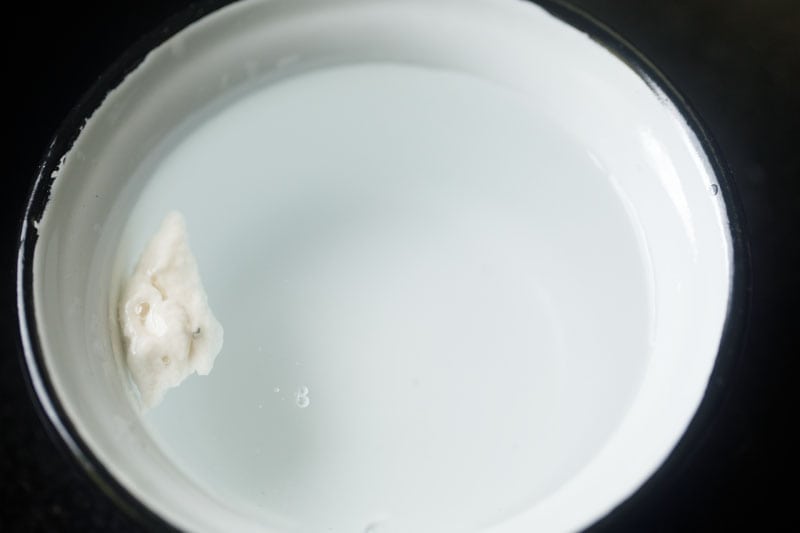
Add Spices, Herbs to Vada Batter
9. Measure and keep all the ingredients ready for making the batter. To the batter, add the following spices and herbs:
- 1 tablespoon chopped curry leaves
- 1 teaspoon finely chopped green chillies
- 1 teaspoon finely chopped ginger
- 1 pinch asafoetida
- ½ teaspoon cumin seeds
- ½ teaspoon lightly crushed black pepper – can use whole peppercorns as well. The addition of black pepper gives a good taste but is optional.
- ½ teaspoon salt or as required
You can also add ⅓ cup finely chopped onions or shallots; 2 tablespoons of chopped coriander leaves and ¼ cup chopped fresh coconut pieces.
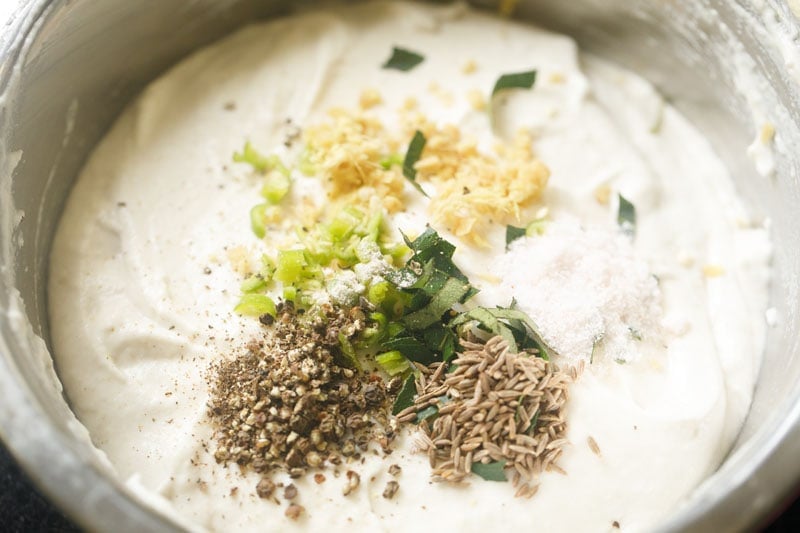
10. Mix the batter well with the herbs, spices and salt. You do not have to ferment the batter. You can use it right away. Check the taste of the batter and, if needed, add some salt.
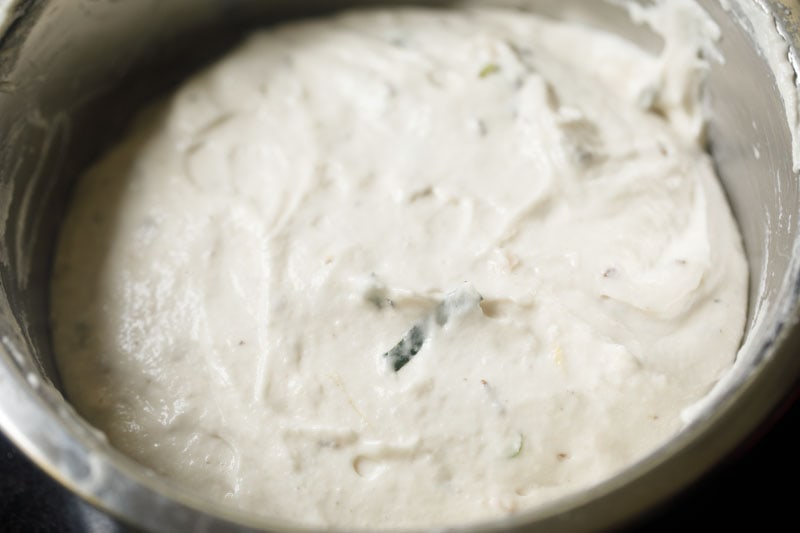
Shape Batter
11. Take a bowl of water. Apply some water from the bowl on both your palms. Take some batter in your right palm from the bowl. Give it a round shape by moving it in a circular position in the right hand.
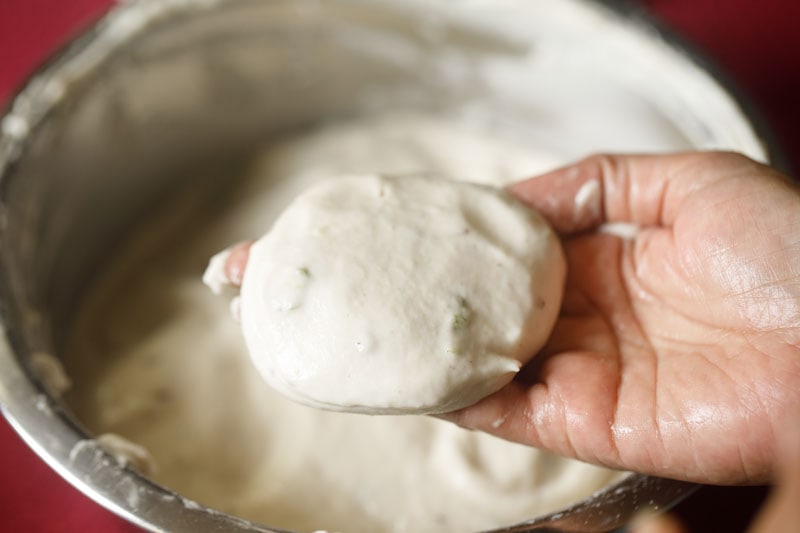
12. With your thumb make a hole in the center. You can also use banana leaves or zip lock bags to give the medu vada its doughnut shape.
Tip: If the batter sticks and you are not able to shape it then add 1 to 2 tablespoons of rice flour to the batter and mix well. This happens if the batter has become slightly thin which means that there is more water in it.
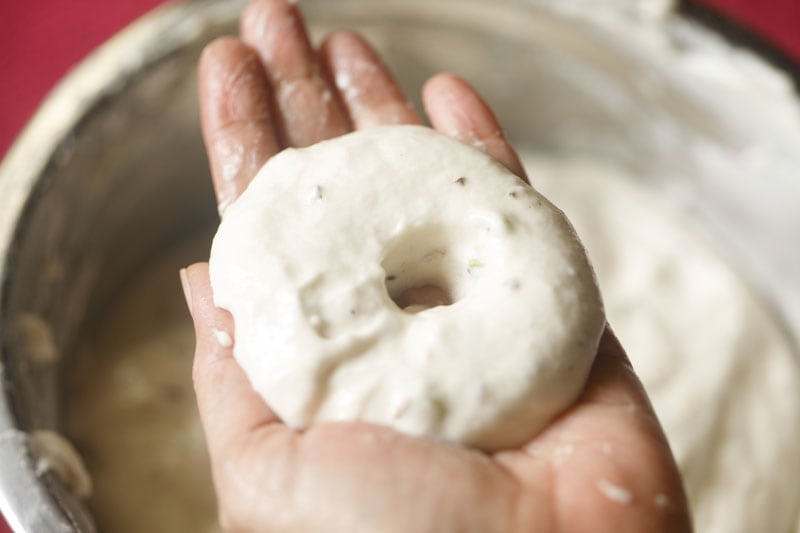
Fry Medhu Vadai
13. In a kadai, heat oil over medium heat. Once the oil becomes hot, slide the medu vada gently into the hot oil. Be careful here! The oil can sputter and pop over quite a distance, so I recommend wearing an apron and long sleeves to protect your skin and clothes.
Tip: If you do not care about the appearance of the doughnut shape of the medu vada, then just drop spoonfuls of the batter directly in the oil.
Do not overcrowd the pan. Work in batches, considering the size of your pan as your guide.
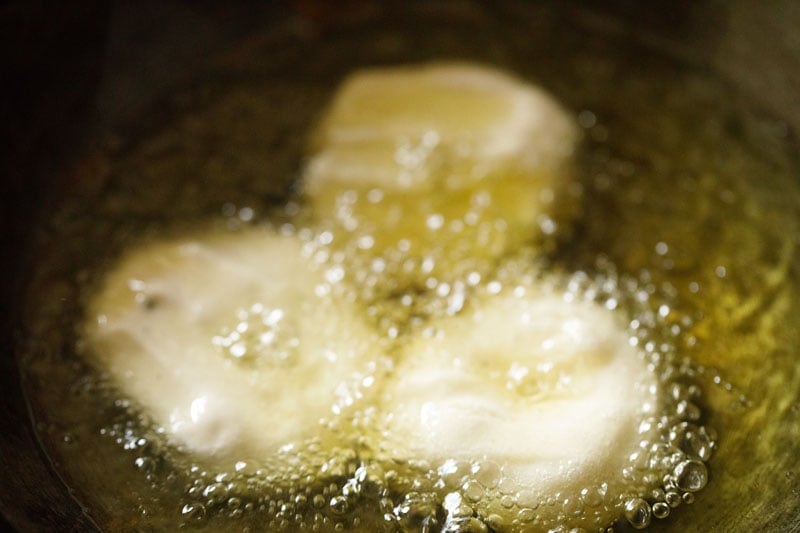
14. Once the vada or garelu are slightly golden and the batter has firmed up and looks crispy, then gently turn over with a slotted spoon and continue to fry.
The oil should not exceed 190 degrees celsius (375F), or fall below 175 degrees celsius (350F).
Remember: oil that is too hot will quickly brown the vada from the outside, but they will remain uncooked from inside. Oil that isn’t hot enough will make the vada absorb too much oil and become greasy.
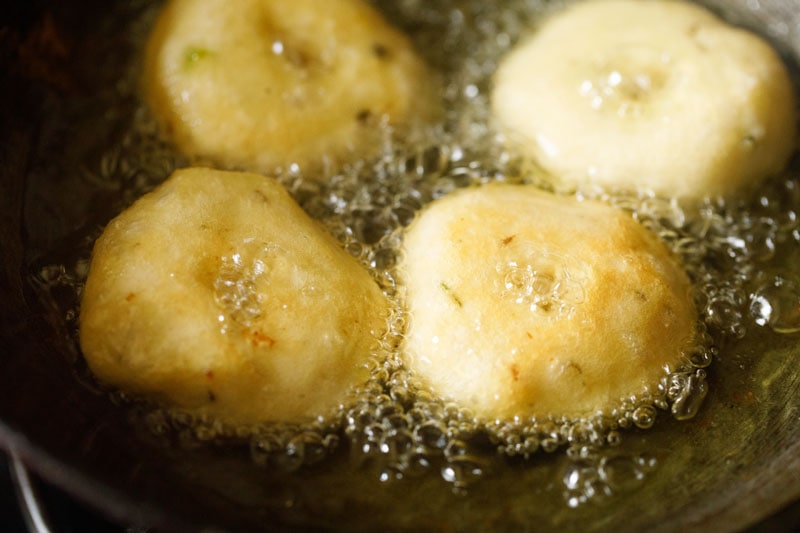
15. Continue to fry the vada, turning over as needed.
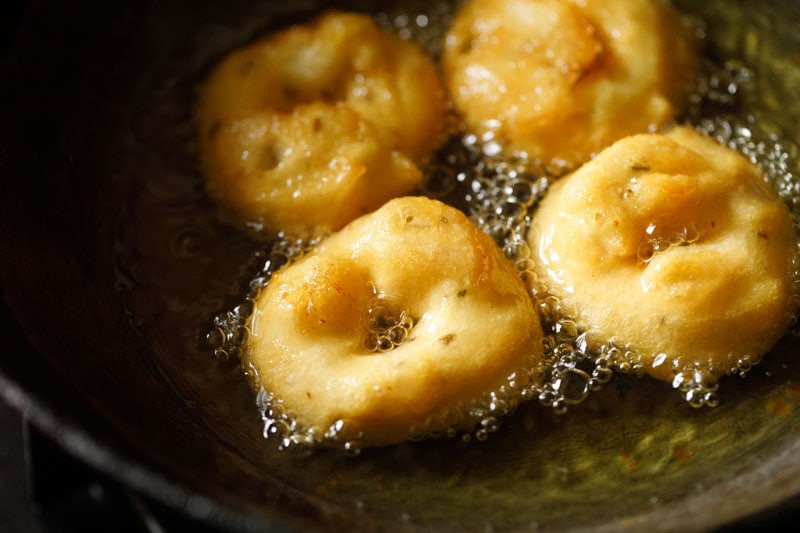
16. Fry the medhu vadai till crisp and golden.
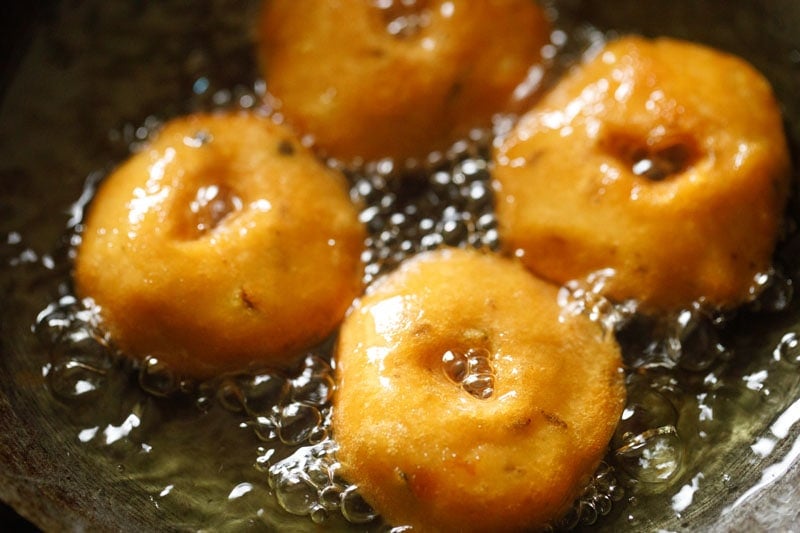
17. Once the medhu vadai is crisp and golden, then remove with a slotted spoon to drain the extra oil. Fry the rest of vadai in the same manner.
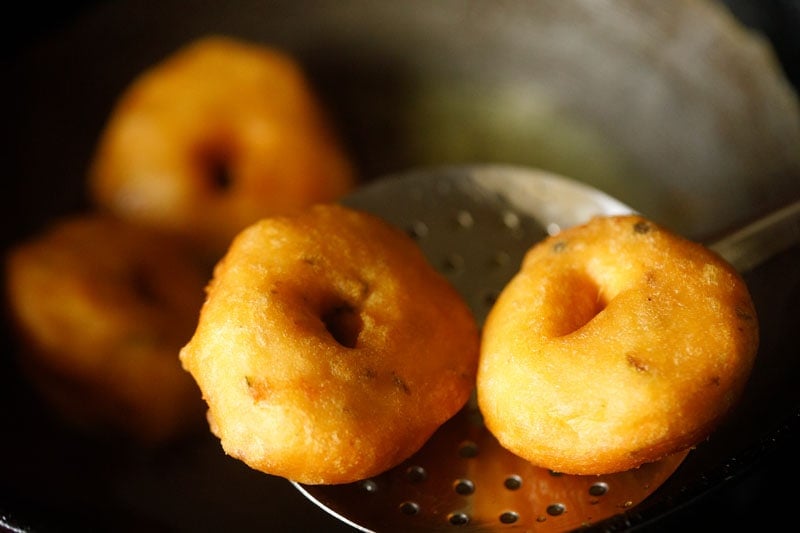
18. Drain them on kitchen tissues to remove extra oil. This way shape the vada batter and fry them in hot oil.
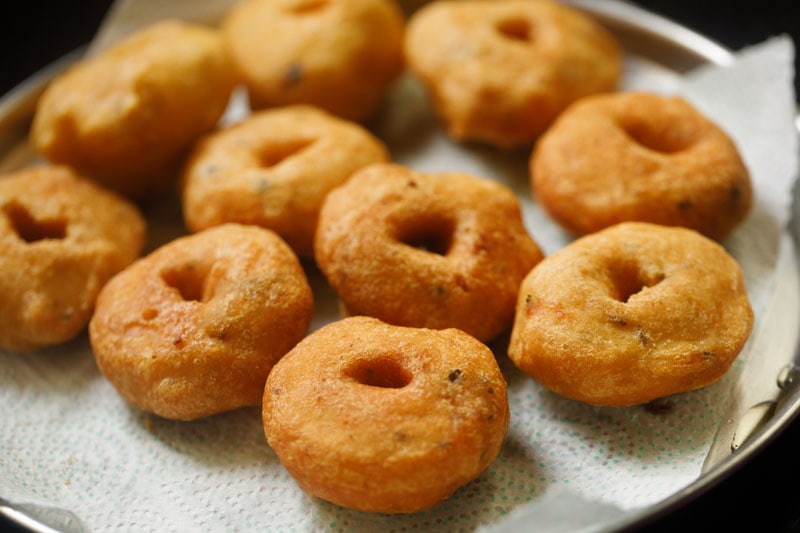
19. Serve Medu Vada or Garelu or Uzhunnu Vada hot or warm with sambar and coconut chutney. Enjoy!
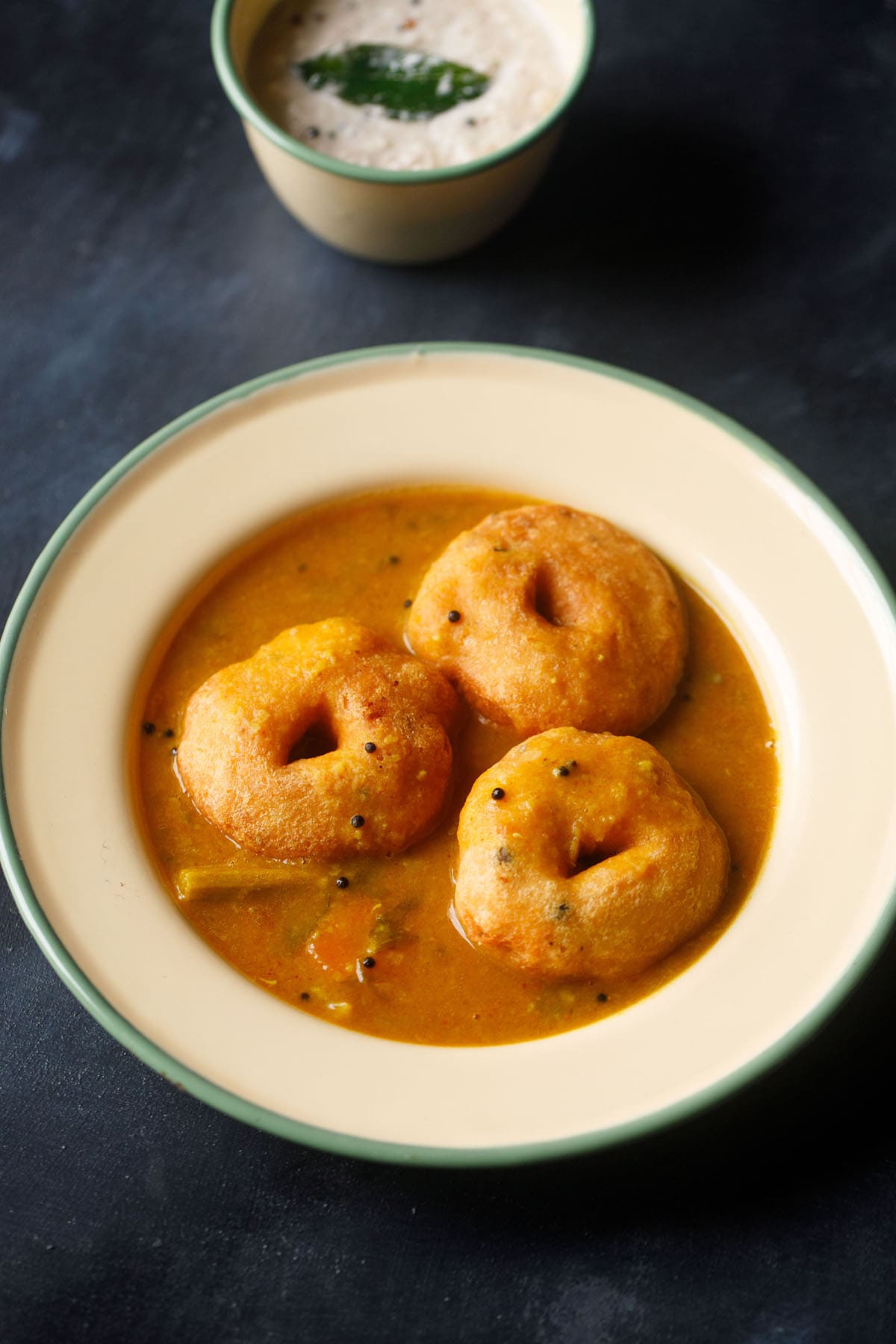
Sambar Vada
To make sambar vada, you can make any of the sambar varieties I have listed below. Depending on the veggie stock in the kitchen, I make sambar with just one veggie or a mix of various of them.
Vada and sambar are a match made in heaven, so even if you make your sambar without any veggie, it will still be a joy to eat.
- Sambar – Classic South Indian Sambar made with mix vegetables, lentils and sambar powder
- Hotel Style Sambar – If you love hotel style flavors in your sambar, you will love this variation where the sambar masala is made with freshly roasted spices and lentils. You can even pair this sambar with idli.
- Onion Sambar – This sambar features small onions or pearl onions together with lentils, tamarind and spices.
- Drumstick Sambar – A variation made with drumsticks which are fresh moringa pods and tastes too good with medu vada.
- Arachuvitta Sambar – Is made with coconut ground with freshly roasted spices and has a fantastic taste and flavor.
FAQs
Uh-oh, sounds like one of two things happened. If the batter is thin, then the vada will absorb too much oil during frying.
But even if the batter is perfect, you need to heat the oil properly – if it is warm or not hot enough, the vada will also turn out greasy.
Ooops, sounds like you didn’t blend/grind the batter enough. When the urad dal is almost the consistency of whipped cream, you have reached the right consistency.
Be sure to use a powerful (750+ watt or more) grinder or blender or a table-top wet grinder for the best results.
Also, please be sure to soak the urad dal for at least 4 to 5 hours or even overnight. If the dal aren’t well soaked, they will not grind to a soft, fluffy batter.
Ensure that you use fresh urad dal in its shelf period. Aged or old urad lentils will take a lot of time to grind or blend and can also make the vada dense or hard.
Sounds like your batter was too thin. Try adding a bit of rice flour or semolina to the batter to thicken it up; it should be the consistency of a thick cake batter or like whipped cream.
As with most donuts or fried goods, these savory fritters are best served hot from the frying pan (after draining oil, of course).
That said, any leftovers will keep for up to a day. To reheat, warm them in an oven until hot to the touch.
You can also make the batter up to 1 day ahead of time. Keep it in the fridge until you are ready to fry. Let the batter come to room temperature before frying.
Absolutely; it can either be halved or doubled depending on how many vada you want to make!
I use either sunflower or ground nut oil for deep frying, but any neutral oil with a high smoke point will work. Safflower, vegetable, or peanut oil are all acceptable substitutes.
More Popular South Indian Snacks!
Breakfast Recipes
Breakfast Recipes
Breakfast Recipes
Breakfast Recipes
Please be sure to rate the recipe in the recipe card or leave a comment below if you have made it. For more vegetarian inspirations, Sign Up for my emails or follow me on Instagram, Youtube, Facebook, Pinterest or Twitter.
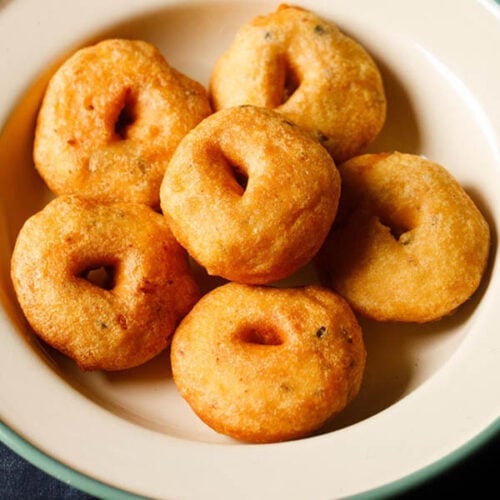
Medu Vada Recipe | Sambar Vada
Ingredients
- 1 cup urad dal (husked and split or whole black gram) – 200 grams
- 2.5 to 3 cups water – for soaking
- 3 to 4 tablespoons water – for grinding or blending lentils
- ½ teaspoon cumin seeds
- ½ teaspoon black peppercorns whole or crushed
- 1 tablespoon chopped curry leaves or 7 to 8 curry leaves
- ⅓ cup finely chopped onions – optional
- 1 teaspoon chopped green chilies or 1 to 2 green chilies
- 1 teaspoon finely chopped ginger
- 1 pinch asafoetida (hing) – optional
- ¼ cup chopped coconut pieces – optional
- 2 tablespoons chopped coriander leaves – optional
- ½ teaspoon salt or as required
- oil for deep frying, as required
Instructions
Making Vada Batter
- Rinse urad dal a couple of times in fresh water. Then soak the lentils for 4 hours or overnight.
- Grind or blend the soaked lentils to a smooth batter with water.
- If the batter becomes watery, then the instant relief would be to add some semolina or urad dal flour or rice flour to it.
- Add all the spices, herbs and salt. Mix well.
- Take a bowl of water. Apply some water from the bowl on both your palms. Take some batter in your right hand from the bowl. Give it a round shape by moving it around.
- With your thumb make a hole in the center. You can also use banana leaves or zip lock bags to give the medu vada its doughnut shape.
Frying Medu Vada
- In a kadai (wok) or pan heat oil for deep frying. Keep the heat to medium.
- Once the oil becomes hot, slid the vada gently and carefully into the hot oil.
- Shape the batter this way and gently slid them in the oil. Don't overcrowd the kadai or pan with the vada.
- Once the vada is slightly golden then gently turn over with a slotted spoon and continue to fry.
- Fry them till crisp and golden. The oil should be not very hot, but medium hot. You want the vadas to be cooked from inside. Very hot oil will quickly brown the vadas from outside but they will remain uncooked from inside. Less hot oil will make the medu vada to absorb too much oil. Even if the batter is thin then also the medu vadas will absorb too much oil.
- Fry all the medu vada this way till they become evenly browned and crisp.
- Drain them on kitchen tissue to remove excess oil.
- Serve the medhu vadai, hot or warm with sambar and coconut chutney. It can also be served with other dips like mint chutney, coriander chutney, tomato sauce or onion chutney, tomato chutney etc.
- One of the best combination is sambar vada where these medu vadai are dunked in piping hot sambar and served with a side of coconut chutney. This vada sambar meal is finished with steaming hot filter coffee.
Nutrition Info (Approximate Values)
This medu vada recipe from the blog archives was first published in October 2011. It has been republished and updated on Jun 2022.

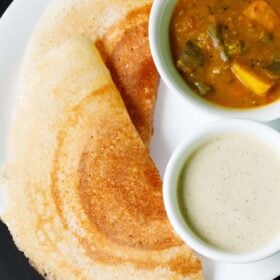
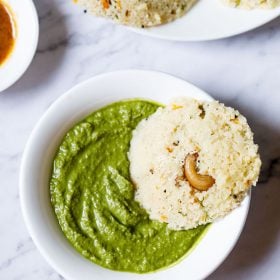
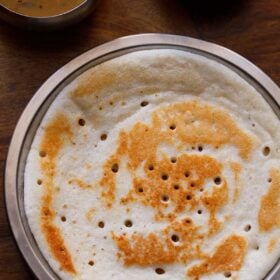











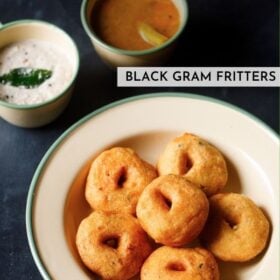
Dear sir, I made medu vadas as per ur recepie the taste was awesome. But one problem was there that the vadas were little hard to it. I did not add any water while grinding nor did I do frementation. Can u plz suggest me how to make them soft without fermentation.
medu vadas do not need fermentation. hardness could be due to the batter not being ground properly. the batter should be light and fluffy. even if you briskly stir the batter, with a spoon for a couple of minutes, the vadas will be soft. a bit if water added while grinding will also make them light and soft. before frying, check a small piece of the batter in the oil. if its soft and and light, then the batter is good. if it is hard or dense, then add 1 to 2 teaspoons of water and/or stir the batter briskly with a spoon for a couple of minutes.
Good Information for break fast.
thankyou ramkisan 🙂
Hi, thanks a bunch.
I came across your site when I wanted to save myself from the little disaster I made.
I had washed the lentils dried them roughly for 2 hours and ground tthem in a dry jar.
Soaked overnight. Morning woke up to see the cconsistency gone thin.
Your one line to add semolina saved me.
Thanks. The batter is yet to be tried this eevening.
I was told by my sis to add a pinch of soda to the batter 5-10 minbefore frying.
you are welcome ash and let is know how the vada was?
Hello there,
I’ve been cooking south Indian food for around 1 year. My husband is from Bangalore and loves when I make his “home food” (we currently live in the UK)
Your medu vada recipe is the best I have tried so far! He tells everyone how great my vada is… I can’t take credit! Thank you so so much for providing this tasty recipes.
Only problem is… I’m addicted to vada now haha!!!
I was just wondering how long the batter lasts? Ive used it the next day, would it last 2 days in the fridge?
Thanks for your time!!
thankyou so much elizabeth glad your husband liked the medu vadas 🙂 the batter should last for 2-3 days in the fridge just refrain from adding salt to them for a longer life shelf. hope this help’s you.
Really its help a lot thanks its really worthy I mean your recipe is very simple that’s the favourite part of this
thankyou so much Jaipal 🙂
Thank uuuuuu so much for ur recipies…….,
welcome and thankyou Anjali 🙂
Hello…thnk u soo much fr ol d lovely receipi …u explain everything vry nicely. .n especially ur explanation with step by step images make everything easy..well m in graduation bt only bczz of ur site. .I ll able to make each n everything. .thnqqqqqqq sooo much:-):-)
welcome pratibha. glad to know this. thanks for sharing your positive review.
Well, this is getting predictable. Oh yes, yet another brilliant success story. ? The recipe is food Luddite proof given the water floating test. It was great fun adding a few drops and grinding until finally, at last, the floating happened. If only there was such a test for the fermented batters….I could graduate the idli, dosa and appam classes with honours instantly without so much homework. Vadas are sooooooo easy, especially when you have Dassana teaching you from her virtual kitchen. With her help I now have my PhD in Vada management – after only one class!
So were they any good? Well let’s see if the empirical evidence stands up in court. “So Dr Vada, did you or did you not serve your wife Vadas with coriander chutney? Also with yoghurt and Imli?” Yes your honour she had Dahi Vada, I drowned it in yoghurt and drenched it in imli sauce. She then proceeded straight away to drown another in coriander chutney.” “Hmmm and did you bring any Vadas for me to taste?” “No your honour they were all gone, I turned around and all 10 were missing.” Hmmm, unacceptable, I sentence you to cook 30 Vadas a month for your wife.” ?
thank you rohit as always. the way you write is really good and brings a smile every time i read your comment. the water floating test is the true test to check the consistency of the batter. for the fermented batters, there is no such test. its just practice and experience that is needed for the fermented batters.
What is the oil used to make .which one makes less absorb .is it groundnut or sunflower oil
i use both sunflower and ground oil for deep frying. to make the oil get absorbed less, the oil has to be hot whenever you fry any food in it.
Hello, I recently started cooking and most of my learning has come from your site as that’s the first one which pops up when I type any recipe name in Google. So thanks for your guidance.
Anyway I made medu wadas today following your exact recipe, but they turned out hard, I had soaked whole skinned urad dal for about 11 hours, what could have gone wrong?
the batter needs to be ground very well and should be fluffy. if the batter is not ground well, then the vadas become hard.
Thanks . Adding rava made vada yummy.
welcome sheetal
Hello Dassana and Amit.
First of all. let me congratulate you both on your excellent website and the pleasure, and knowledge, it has given to millions. 😉
Next, … I am so old, that when I first came across your name …. the first thing I could think of was ….. ‘thats more than half a rupee – Dus anna is more than 8 annas !’ . Old joke.
Today, is March 14, 2015. Saturday. …. in the US known as ‘Pi’ day. Because Pi = 3.14 15 926 53 hence under the US convention – 3/14 – the 14th of March, (20)15, at 9.26 am, and 53 seconds past.
Anyway, at 4 am this morning I decided I wanted to make Medu Vada. I have not made it in 4 years because my wife hates oily fried food, with a passion. But I had dreamt of it, last night, so I woke up surreptiously, like a cat, and went downstairs to use a Gits mixture for the vadai. The Gits packet was outdated, by 3 years, so useless, and I decided to make it ‘from scratch’. My wife wakes up at 4 am everyday, to go to work – but today, being a Saturday, she was still asleep snoring like a cat in catnip heaven. Since it is -8oC outside, I warmed a bowl of water and soaked 2 cups of split urad dal, and waited for an hour. Meanwhile I made some sambar with 3 pounds of exotic indian vegetables like ridged gourd (luffa – turai, turiya )and shallots and tendli (ivy gourd) and made a good sambar. Then I read and followed your recipe , ground the urid, added hing, ginger and green chillies, and fried in hot oil. And it came out great.
Then I rushed upstairs, and woke the wife, and gave her the steaming dish. Then I asked her.’Honey, how does it taste?’….. she ignored my question and asked one of her own,’How much peeth (dough) did you make?’. That line is worth a paragraph …..
It means – I really dont care about how good the food is —- but I KNOW you probably made a tonne of it and we’ll be eating medu vadas, out of our nose, for the next 6 weeks, ….. until we are sick to death, and I will have to make a garland of vadas and wind it around your wretched neck, and hang you upside down ….. After 35 years of married life, my wife has superlative ESP…
Enjoy the rest of the day, and the coming week. ;-D)
thanks gary ji for this sweet as well as humorous comment. i must say you are a good writer for someone who likes to read in leisure with a cup of tea. your comment reminded me of my grand father who use to tell that there use to be 16 annas in one rupee… and from 1 rupee or few annas how much ‘mun’ (unit for measurement) of flour or rice could be bought in good old days. women are always practical as far as household things are concerned. wishing both of you a nice day.
Dear Dassana,
Thank you for your reply and also for not deleting my post …lol. ;-D) I nearly deleted my own post, because it appeared to be so irrelevant and irreverent of your blog. ….. ^_^ ….. Despite of what I wrote yesterday, I am very appreciative and very much in love with my wife – and I think I am the luckiest man in the world, SOLELY because of her.
I was born in independent India, and until a few years ago, when I started losing my eyesight (long story – ) – I was an avid collector of old Indian coins and currency notes. I have all the original coins that were issued pre-independence and post- indep and also a Bombay mint issue that was a commemorative of the actual independence (day – )of India – which says ‘Jai Hind’ , on the obverse and reverse sides, and was distributed free to all the schoolchildren, in the schools, on that day, 8/15/1947. I also have 10 and 20 Cash (Kasu) coins from Madras, of the East indian co. ( Yes, ‘cash’ was a tamilian east india co. coin – ) and also a ‘Chukram’ ( a coin from the esrtwhile Travancore state). One Travancore Rupee = 7 Fanams , 1 Fanam = 4 Chuckrams, 1 Chuckram = 16 Cash. Plus to make it more complicated, One British India Rupee = 28 Chakram 8 cash. (!!!) …. and One Travancore Rupee =15 annas and 6.83 pies of British India. (per Wikipedia – ).
No wonder indians have to be so good in math and addition and subtraction. ;-D))
Have a great week, and continued good wishes for your website and blog.
welcome gary ji. i found your comment interesting. previous comment will be appreciated by many foodies so how can i delete it. the coins which u have collected is antique now. most of us have no idea about the old style currency and coins. i liked reading it. i hope someone from your generation pen down all this interesting info so that its not lost. i must say again, you have a good style of writing.
What makes idli vada and sambar great is, idli must be grainer (use idli rice/rawa), Vada must be less dense and more crispy so that it can soak in sambar.
There are many techniques to attain this for example, always grind urad dal using stone wet grinder, this ensures pluffy consistency of batter.
Adding cooking soda or semolina gives crispness.
Another technique is deep frying twice.
thanks for these tips and suggestions madhusudhan. i have a stome wet grinder now and it does make a lot of difference to the idlis and dosa texture when grinding urad dal. the same fluffiness can be achieved in a mixer-grinder. for medu vada i use the regular mixer-grinder to grind urad dal, but for dosa and idli i use the stone grinder. agree on cooking soda and semolina. deep frying twice is new to me. never tried this way.
Thee recipe sounds really good. but when I tried to make them fluffy the. vada turns out flat. do I have to add yeast to the batter..If so. then how much?
the vadas turned out flat as it has more water. just add a few tbsp of rice flour or rava to thicken the batter.
Nice